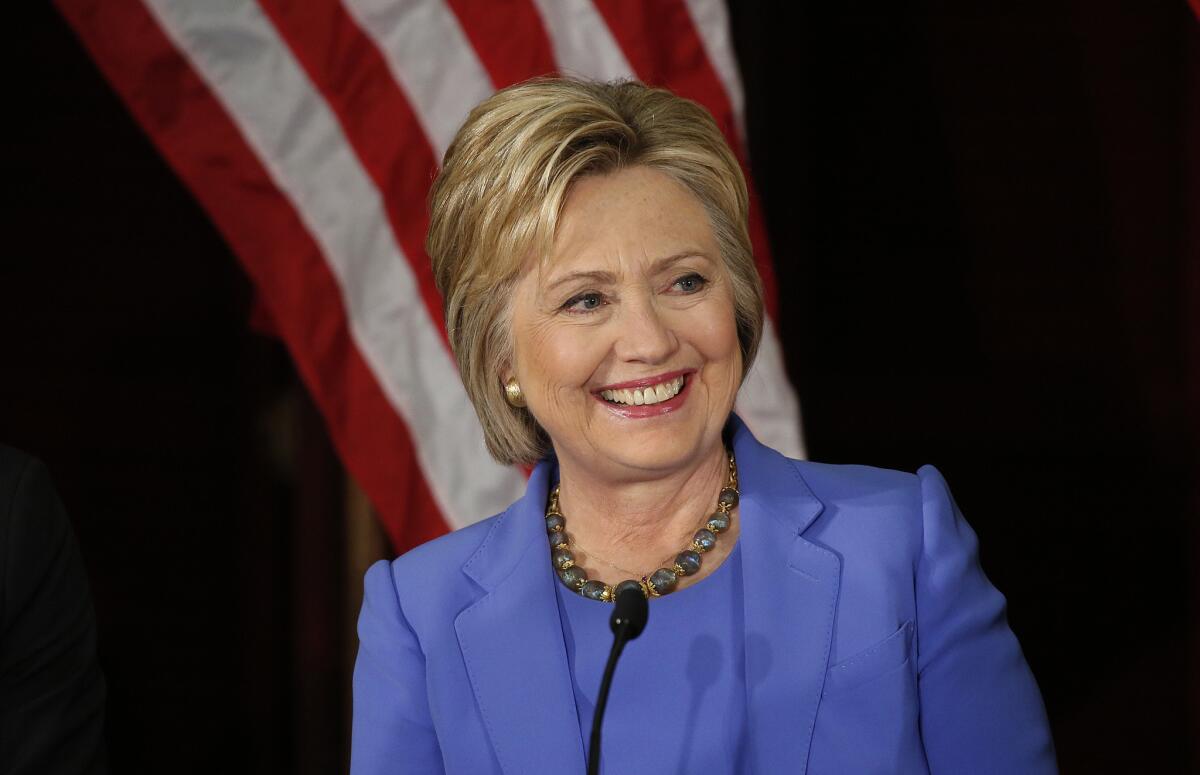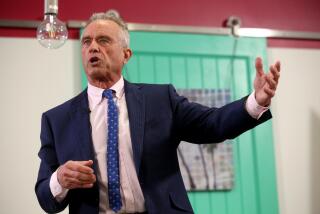How far left has Hillary Clinton been pushed by Bernie Sanders? Less than you might think

Hillary Clinton campaigns in Los Angeles on March 24.
Reporting from Washington — Hillary Clinton has angrily rebuked Bernie Sanders for branding her a moderate. She gives stump speeches that sound so much like his that a “Saturday Night Live” parody has Clinton morphing into the 74-year-old socialist as she talks. Progressive activists boast of how far to the left they have pushed her.
But what do voters see when they assess Clinton?
Pretty much the same person they did before she entered the race: a candidate in the same ideological space as mainstream Democrats like President Obama. Her rants against Wall Street, push for massive college tuition subsidies and caution about free trade have done little to change wider voter perceptions of Clinton’s ideology. Neither have her crusading for gay marriage, unrelenting demand for tough gun control, nor her warnings of putting coal miners out of work.
Experts who closely track the public’s impression of Clinton are finding that her fiery, populist talk on the campaign trail that Republicans claim will repel swing voters has yet to do much of that – even as liberal activists express satisfaction that Clinton has embraced so many of their demands over the last year.
Election 2016 | Live coverage on Trail Guide | Track the delegate race | Sign up for the newsletter
“People feel they know her and have a long enough history with her,” said Mason Harrison, political director of Crowdpac, a Silicon Valley firm that assesses public perceptions of presidential candidate ideology by tracking the leanings of millions of donors. “A lot of what candidates say on the campaign trail is cheap talk. I’m not sure people are swayed by it.”
Clinton began the race with a relatively liberal rating on Crowdpac, but one that was no more to the left of that of Obama. A year into the campaign? She is at the same place.
“Her support base hasn’t trended to the left in any meaningful way,” Harrison said. Donald Trump, by contrast, has lurched far to the right on the Crowdpac scale.
A group of 3,000 people surveyed by the Rand Corp. in December rated Clinton as being about as liberal as the average registered Democrat. The group was asked again just this month after voting in the contentious primary had gotten underway and Clinton had seemed to shift left to regain her footing as Sanders had begun winning states.
Voter impressions of her, though, were unchanged. In fact, voters even perceived that she had drifted slightly closer to the center.
This did not surprise John Sides, a political science professor at George Washington University and coauthor of “The Gamble: Choice and Chance in the 2012 Presidential Election.” The public isn’t and won’t be tracking her every policy shift the way activists might, he said.
“Once you get to the general election, people who are up for grabs are less attentive than committed partisans,” he said. “The positions she has taken in this campaign place her to the left of center, but they don’t place her so far from the center that there is a real substantial risk for a penalty for extremism.”
In the last presidential election, Sides said, the average voter’s ideology was closer to that of Republican nominee Mitt Romney than Obama, indicating candidates do not need to be closest to the center of the electorate to win. And Clinton’s strategy is to rebuild the same coalition of voters that Obama did in both his victories.
Nevertheless, a debate is raging among activists over whether the primary election has changed Clinton and, if so, whether the changes will stick.
After Clinton’s big wins on Super Tuesday, when she racked up a delegate lead over Sanders so substantial that she became a prohibitive front-runner in the race, the Progressive Change Campaign Committee, a liberal powerhouse, announced the night was hardly a disappointment for the grass roots. After all, group co-founder Adam Green told reporters, Clinton was no longer the centrist candidate she was when the race began. These days, according Green, Clinton more closely resembles the liberal wing’s standard-bearer, Sen. Elizabeth Warren of Massachusetts.
To support his argument, Green offers a laundry list of positions Clinton has taken: her call to jail rogue Wall Street bankers, to break up “too big to fail” banks, to expand Social Security, to make public universities debt-free. He points out how Clinton sought to get to the left of Sanders on several of these issues.
Clinton has “fundamentally shifted the center of gravity in the Democratic Party,” Green said.
Others say that is exactly what Clinton successfully avoided doing, and that wishful progressives are misinterpreting some of her campaign rhetoric. Centrists in the party, who argue Clinton’s big delegate lead in the primary is a vote of confidence in their approach, point to all the Sanders policies that Clinton rejected.
She is against free college for everybody. She is against a European-style, government-provided healthcare system. She is against reinstatement of the Glass-Steagall restrictions on financial institutions. Even on trade, Clinton is in a very different place than Sanders, they note, expressing openness to supporting a renegotiated Pacific trade deal.
“There is this myth that the left is perpetuating that Hillary Clinton has moved sharply left in the primary and is going to be running as a Sanders liberal in the general election,” said Jon Cowan, president of Third Way, a centrist advocacy group that advises Democrats. “It is simply not true.… She is coming out of the primary as a ‘new-economy Democrat.’”
Part of the disagreement stems from the fact that the meaning of “new-economy Democrat” itself has shifted left over the last decade. Some of the key pro-growth Democrats who helped shape former President Clinton’s economic policies say that the same agenda is no longer sufficient to narrow the growing income gap in America, and that it needs to be adjusted to include a larger safety net, more restrictions on Wall Street and trade deals that provide more protections for American workers.
It is also an election year in which campaigning on a theme of economic populism is hardly risky. The message appeals across party lines and has propelled the candidacy of GOP front-runner Trump.
“Rhetoric that challenges certain elites like Wall Street banks is pretty safe,” Sides said. “It is the same rhetoric the tea party used too.”
Twitter: @evanhalper
ALSO:
Donald Trump leads in California primary race but threatens a GOP fracture
Clinton email probe enters new phase as FBI interviews loom
More to Read
Get the L.A. Times Politics newsletter
Deeply reported insights into legislation, politics and policy from Sacramento, Washington and beyond. In your inbox three times per week.
You may occasionally receive promotional content from the Los Angeles Times.











